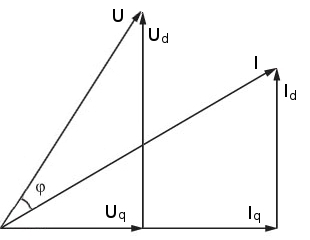Power factor
Ratio between real power and apparent power.
The power factor cos(φ) is defined as the ratio between real power and apparent power consumed/produced by the electrical machine. The power factor is a dimensionless number between -1 and 1. In Emetor, the power factor cos(φ) is calculated from the phase angle φ between the phase current and the phase voltage, refer to Fig. 1:
$$\cos\left(\varphi\right) = \cos\left(\tan^{-1}\left( \frac{U_d}{U_q} \right)-\tan^{-1}\left( \frac{I_d}{I_q} \right)\right)$$
Fig. 1 Illustration of the power factor calculation.
When designing an electrical motor, it is generally of interest to aim at a high power factor. In such a way, it can be avoided that the supply has to provide excessive reactive power to the motor, and the current necessary to obtain rated power can be effectively limited.
Read about another glossary term
